Waterproofing
Property
Components Classification
Based on the characteristics and the basic material, waterproofing systems can be generally classified into 3 main categories, namely [1]:
Preformed Membrane/Sheet/Roll
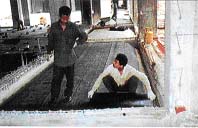
This type is suitable for large area with minimum protrusions, thus in Singapore it is not commonly used in the internal wet area. It is practicable to be used in area such as concrete bridges, flat roof, basement and tunnels. It’s either self-adhesive or bonding agent has to be used.
The base of this system can be either Bituminous (i.e. Asphalt, Bitumen, modified Bitumen) or Non Bituminous (i.e. Ethylene-Copolymer Bitumen (ECB), Polyvinyl Chloride (PVC), Polyethylene (PE), Chlorinated Polyethylene (CPE), Butyl Rubber, Ethylene Proplyene Diene (EPDM), Neoprene, Polysobutylene (PIB), and Bentonite clays.)
Liquid applied membrane
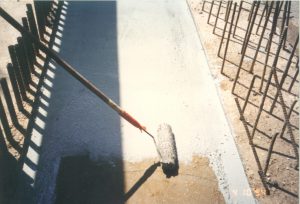
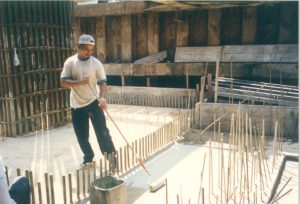
Liquid applied waterproofing system is a single component, liquid applied, elastomeric waterproofing membrane based on highly elastic organic polymers. The liquid applied waterproofing system can be reinforced with fibreglass mat for extra strength in areas where high stress may be encountered such as around pipes and up stands. This system is seamless and therefore eliminates potential failure due to poor joints.
Liquid applied system is preferred to be used in the internal wet area, due to its continuity between horizontal and vertical planes, around projections and penetrations and some of them come in self-leveling property.
The base of this system can be either Bituminous or Non Bituminous (i.e. Acrylic, Epoxy, Polyurethane (PU), Polyisorene/ rubber, Cementitious, etc).
However, generally Liquid applied system can be classified into water based and solvent based.
Integral waterproofing
Integral waterproofing usually refers to admixtures that are supposed to decrease the water permeability of structural concrete. This is not just a matter of concrete mix but also involves issues in structural design and the manner of handling of the concrete in the field. Detailing and location of joints and reinforcing steel as well as quality control in mixing, placing, curing, and finishing are more important to water-tightness than adding waterproofing agents to the concrete mix.
It can be applied by brush (as coating), dry shake, or as admixture.
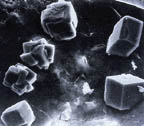 |
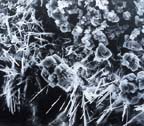 |
 |
| Untreated Concrete | Initiation | Mature |
Source: www.xypex.com
Density
Depending on the type of waterproofing, the density is ranged from 1.2-1.6 g/cm³.
| Preformed membrane | Generally quite dense and sometimes its self-weight may become a deterrent factor due to creep when installed on vertical surfaces such as basement walls. |
| Liquid-applied | Generally low density. |
| Cementitious | Can be relatively dense due to the cement and aggregate contents |
Thermal Conductivity
About 0.691 W/ m²K.
As all waterproofing membranes are relatively thin (0.6 to 4 mm) thermal conductivity is normally insignificant and for roofs, this is usually provided by using a layer of insulation material such as extruded polystyrene, etc.
Water Vapour Transmission
Herewith is the general comparison between different types of waterproofing in terms of water vapour transmission:
| Preformed membrane | Depending on the generic types i.e. bitumen based generally very low vapour permeability while PVC types usual are formulated with relative high vp. |
| Liquid-applied | As above except that vapour permeability is usually affected by the thickness of the membrane and liquid systems tend to have lower thickness therefore generally better vapour transmission. |
| Cementitious | Good vapour permeability due to its structure |
The range of water vapour transmission value for different types of waterproofing system (for sheet membrane and liquid applied only):
| Self-adhesive membrane (thk : ±1.5mm) | 5-15 g/m².24 hr |
| Bituminous membrane (torch on, thk:3-4mm) | 5-15 g/m².24 hr |
| Liquid applied roof waterproofing (thk: 0.8-1mm) | 40-80 g/ m².24 hr |
| Flexible cementitious membrane (thk: 0.8-1mm) | < 30 g/ m².24 hr |
| Elastomeric wall coating (thk: 0.2 mm) | > 80 g/ m².24 hr |
In SS 374: the WVT requirement is < 12g/m².24h.
If the amount of water vapour in the substrate is high and it has to permeate the film of low WVT, there will be a pressure on the film, which can cause debonding from the substrate, resulting in blistering which is common among liquid applied roof coating.
For liquid applied elastomeric wall coatings, the specification is >80g/m².24h
Elastomeric wall coating have higher WVT due to the lower applied film thickness and therefore reduce the risk of debonding from the substrate, caused by the high pressure of water vapour.
Tensile Strength
Range about 4 – 6 N/mm²
Tensile strength provides the ability of the treatment to stretch without breaking.
In areas such as the joints between the floor slab and wall, higher movement is expected. The treatment must be strong enough to hold itself without cracking. Once the treatment crack at this area, water can seep through to adjacent rooms.
It must be noted that tensile strength and elasticity (or elongation) is closely related, as they cannot be both equally high. Normally, when the treatment has high tensile strength, it will not have very high elongation strength and good elasticity.
| Types | Tensile strength |
| Preformed membrane | Generally high especially if reinforced. |
| Liquid-applied | Medium to low depending on generic types and also whether reinforced. |
| Cementitious | Generally low tensile strength and normally not reinforced except at detailing. |
Modulus Elasticity (elongation at break)
The waterproofing treatment has to be elastic to accommodate movement that may be present in the wet areas. Such movement can be found in joints such as areas between pipe penetration and concrete, between floor slab and walls, and between new and existing concrete.
Elasticity of the treatment provides bridging over such areas to prevent water seepage in the event of the movement. Good elasticity of the treatment would mean that it is able to stretch to bridge over defects and recover without losing its integrity.
| Types | Elasticity |
| Preformed membrane | Generally good for non-reinforced. Elongation however, is affected by types of reinforcements (range 50 to 1000%). |
| Liquid-applied | Average from medium to high depending on generic types (range 50 to 700%) ie.
|
| Cementitious | Low, normally at around 150 % for polymer modified type. |
Adhesive Strength
Although the waterproofing treatment in wet areas is mainly concealed (where exposed treatment are installed, the adhesive strength is of absolute importance), the treatment must be relatively strong in adhesion properties.
This is necessary, as we do not wish that the treatment be de-bonded from the substrate, especially on vertical surfaces. This debonding will result in the wall tiles dropping off easily. On flat surfaces, it will result in ‘hollow’ or ‘drummy’ effect.